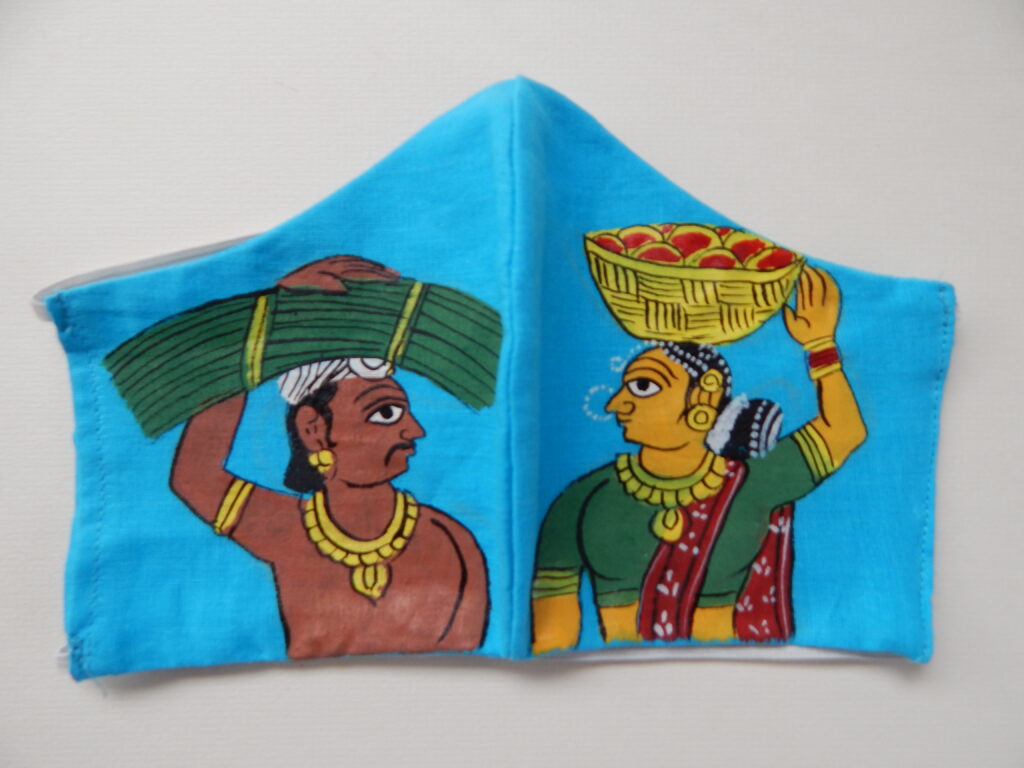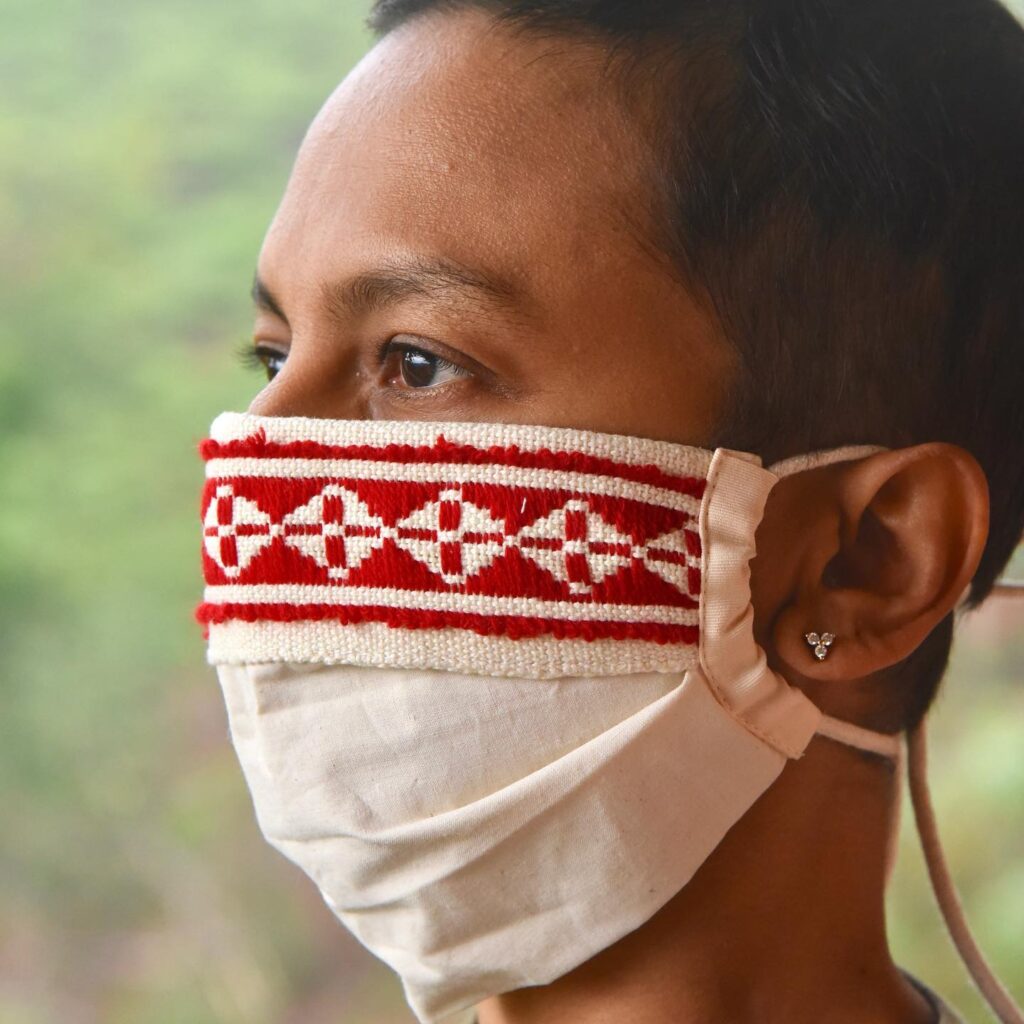
In the remote Cheriyal village of Telangana’s Siddipet district in Southern India, Dhanalakota Saikiran grew up seeing his grandfather painting scrolls all his life. This 500-year-old art form, named Cheriyal, after the village where it originated, has been passed on from one generation of the Dhanalakotas to the other.
“The pandemic had impacted our business with poor sales and canceled exhibitions,” said Saikiran, 28, a Cheriyal artist. “Even our Cheriyal utility products that we started making two years ago weren’t getting enough buyers. So we tried our hand at Covid-19 masks and were surprised at the huge response we got in a short time.”
Cheriyal scrolls served an important tool of storytelling in southern India. Depending on the content volume of Indian epics like the Ramayana, Mahabharata, Skandapurana, the size of the scrolls varies from 15 meters to 30 meters. Every Cheriyal artwork — scrolls, dolls, or masks — follows a seven-step process of canvas preparation, natural dye making, and painting.
“The work demands a lot of time and patience. It took me six months to complete the latest piece of artwork I was working on,” said Saikiran.
Having lost its color with time due to the advent of television and other forms of communication, the craft struggled to survive. Only four families of the Dhanalakota community are the current practitioners of the art.

The art picked up again after the Crafts Council of India, a government body, gave it its due recognition in 1978. Saikiran’s grandfather Dhanalakota Chandraiah won several national and state merit awards between 1979 and 1986. The craft got a Geographical Indication tag in 2010.
“I realized I had to bring in out-of-the-box ideas to stay in business and carry forward the art. Our utility product segment, which includes Cheriyal-themed mobile covers, pen stands, and key chains has done pretty well. The masks are our latest addition.”
Like Saikiran, several artisans who practice various forms of endangered art across India, are using the pandemic to promote their artwork and bring their businesses back on track.
“The designing of masks by craftsperson not only provides them employment, but it also helps by encouraging the buyer to find out more about the craft and appreciate the local art,” said Sunil Sethi, chairman of the Fashion Design Council of India.
“It is during the festive season that people will experiment with different kinds of masks and this is how people will come to know more about the local crafts. This is a big step towards going vocal for local,” he added.

Suhas Ramegowda and Sunita Suhas, a couple based in the Nilgiris, Tamil Nadu, are helping local artisans promote the Toda artwork through its startup Indian Yards.
“Our livelihood program has sold more than 100,000 masks and is still counting,” said Sunita. “We have sold more than 800 Toda masks alone.”
Living high up on the Nilgiri Hills for centuries now — at above 2,000 meters from sea level — the Todas are an indigenous Indian tribe, who survive solely on cattle-herding, dairy farming, and embroidery. Made by their women, Pukhoor or the Toda embroidery is marked by geometrical-patterned red and black embroidery on an off-white cotton cloth.
“Documented references to this art form go back to the 1870s,” said Sunita. “The Todas see this embroidery as their tribute to nature and even bury their dead with the Toda-embroidered cloth covering.”
“Like most tribal craft, the sales are limited to either tourism or exhibitions or retail brick and mortar sales,” she added. “All of these avenues got hit because of the pandemic and made a huge impact on their livelihood. The masks provided some respite as they are much in demand at the moment.”
It is not only a few communities but the entire length and breadth of India that is witness to similar stories of local artisans struggling in the pandemic.

Set amidst the rich cultural history of Gujarat is the 300-year-old Mata Ni Pachedi craft. What started as a sacred textile art for decorating temples of Hindu goddesses, has evolved with time and now finds use in Indian womenswear in the form of saris, lehengas, and dupattas.
Living in Viramgam, the birthplace of the craft, the Chitara is a close-knit community of 20 families who continue to practice the ancestral art.
“The pandemic had brought down our sales to an all-time low, and we realized the pandemic was going to last for long,” said Ajay Chitara, a Mata Ni Pachedi artisan at Viramgam, Ahmedabad.
“I took up a small piece of cloth, made a Mata Ni Pachedi painting, and designed a Covid-19 mask,” said Chitara. “As soon as I shared it on social media, I started getting client requests. I got 520 orders only within a few days. We have just finished selling 2,500 masks and are now working on fresh orders.”
In older days, the lower castes, such as those of Devipoojak, sweepers, and leather workers were prohibited to enter temples. So the Vaghri or Devipoojak community drew deities on large cloth pieces and made shrines where they, along with other marginalized communities, could offer their prayers. They called this art form Mata Ni Pachedi, meaning “behind the mother goddess.”

Marked with vivid colors and bold lines, the artworks are made using block prints or by hand with a bamboo stylus called “kalam.” The colors used are derived from natural dyes such as iron water and jaggery for the color black, and alum for red.
The Mata Ni Pachedi art form was greater recognized after Ajay Chitara’s father, Dilip Vaghi Bhai Chitara, won a state award for his contribution to the craft in 1971.
“It gives me immense pleasure when I see celebrities like Varun Dhawan and renowned Gujarati actors post pictures wearing masks designed by us,” said Ajay Chitara, who took up the craft at an early age of seven. “We want to expand our craft to such an extent that our future generations are willing to adopt it and take our story forward.”
(Edited by Uttaran Das Gupta and Gaurab Dasgupta.)
The post Hand-painted Masks Help Indian Artisans Promote Endangered Art appeared first on Zenger News.
